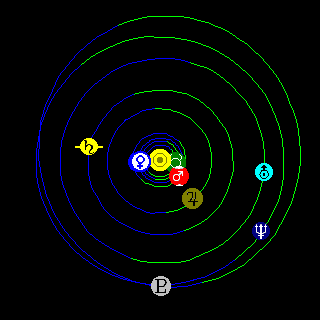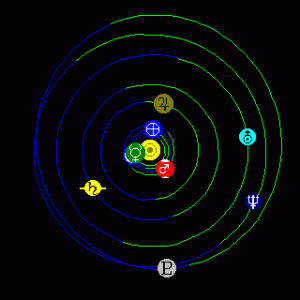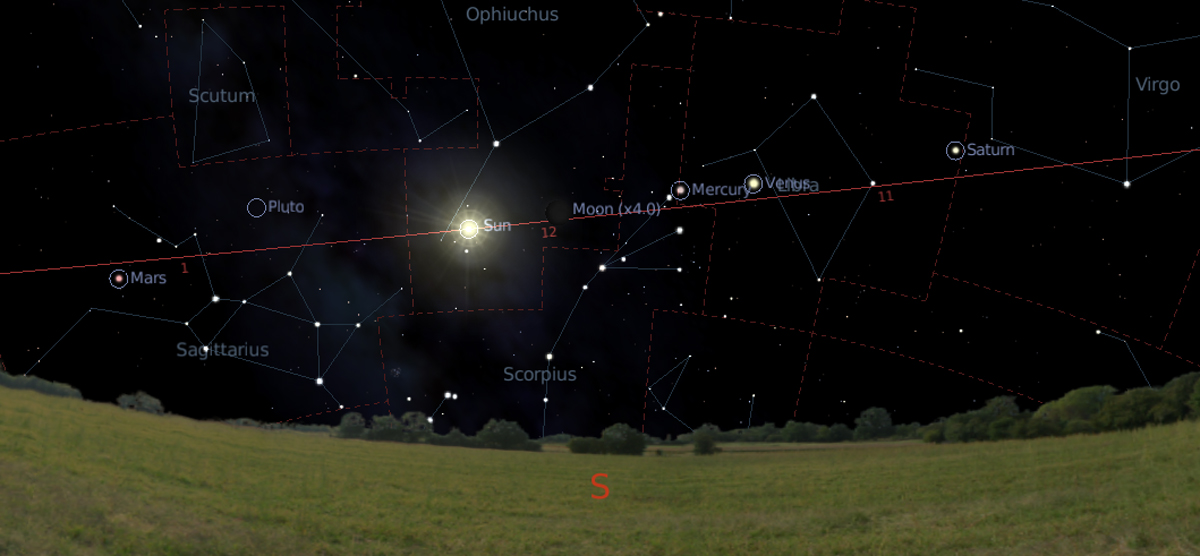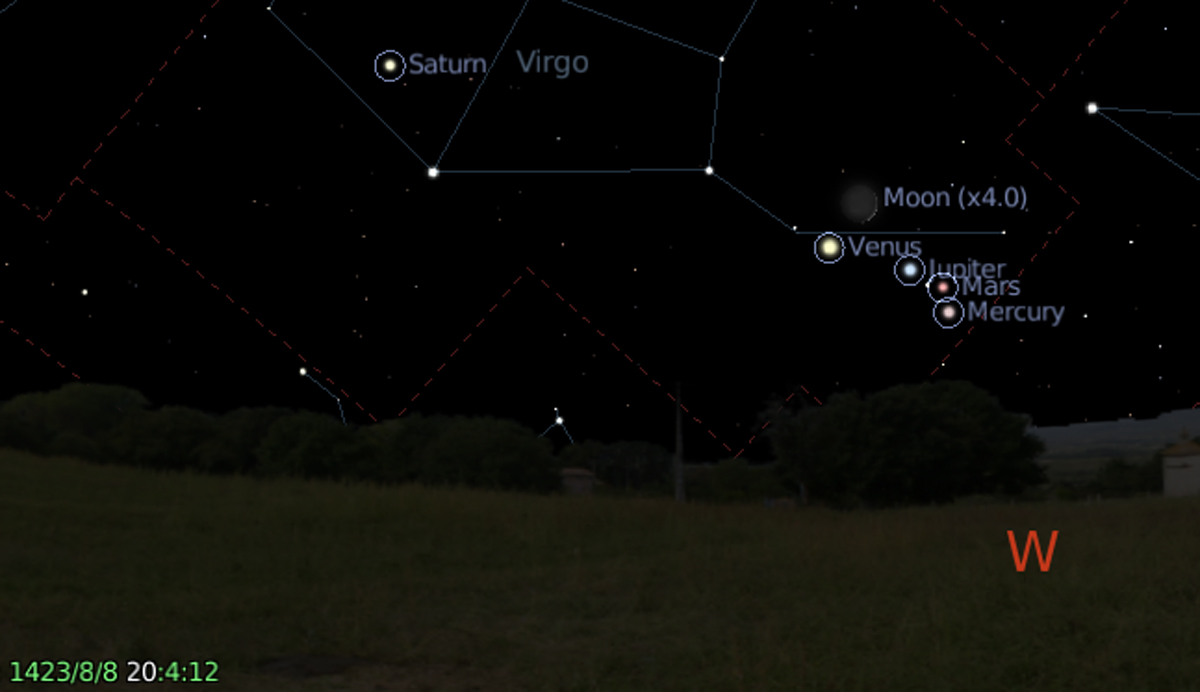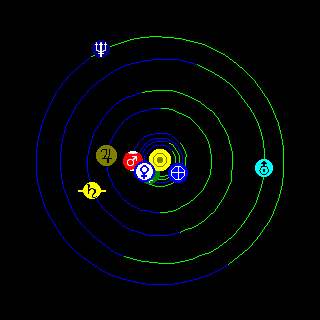Author Archive
 Do You Write About Astronomy?
Do You Write About Astronomy?
If you write about astronomy (or something similar) contact Pamela Gay, she’s doing some hard work for the International Year of Astronomy.
From Pamela:
Here is my need: If you are a content provider, can you please email me at pamela@starstryder.com with the following informing:
Site Name, Site URL, RSS URL, Byline, Tagline, if your site is clean/explicit/somewhere inbetween, and information on what type of feed it is (Blog, images, twitter, video, etc). For office purposes only (where the office is the IAU IYA Secretariat), we also need to know who the correct contact person is, and what their email address is.
And here is my request: If you are a content provider, can you please put out a request on your feeds, your Facebook, and your twitter, to help me find the hidden content providers – the grad students telling their stories of the stars and the research scientists silently slaving over their blogs – so that I can help get their voices heard in the Portal to the Universe.
I’m writing to her right now.
 Planetary Alignment
Planetary Alignment
Question:
“I’m interested in the stars and planets. One thing I always wondered about is if the planets in the solar system ever totally align with each other, so I mean not just a few planets but ALL of them. If this happens, how often does it occur? And is there a name for it? Thank you.”
Note:
This question comes up every once in a while. Partially it’s due to random doomsayers, and partially it’s due to Lara Croft: Tomb Raider, in which there is a planetary alignment causing widespread … actually, I don’t know what it causes, I haven’t seen the movie.
Answer to “Does this happen? How often?”:
This is a difficult question to answer. First off, as an astronomer I have to point out that the planets aren’t all in exactly the same plane. If one of these alignments occured, when you looked down on the solar system from above you would see the planets in a line, if you looked from the side at the same time, some would be a little higher, and some would be a little lower.
Everything I’m reading is pointing to the fact that even that sort-of alignment probably won’t happen. On May 5, 2000, the Earth, Sun, Mercury, Venus, Mars, Jupiter, and Saturn were close to a line, but it wasn’t perfect. Check out this simulator, you’ll have to type in 2000-05-05 in the date field.
Phil Plait over at Bad Astronomy says this: “As it turns out, planetary alignments are fairly rare. Getting more than three lined up is difficult; getting them all lined up is rare indeed. But 5 billion years [the length of time the solar system has been around] is a long time! Alignments may be rare, but given enough time they do occur, and the Earth is still here. Even more, what most doomsayers say is an alignment is really more of a confluence, or loose gathering, of planets.”
You’d think that with the planets going around the Sun for 5-10 billion years we’d get a perfect alignment at least once, but it looks like the math just doesn’t work out.
Answer to “What is it called?”:
The article from almanac.com calls this a “great conjunction,” which is a pretty good word. Conjunction just means that from our point of view the planets end up close to each other in the sky.
Phil Plait would call these things “confluences,” since they’re not a perfect line.
The other word I can think of to describe this is “syzygy” which refers to the alignment of at least 3 celestial bodies. It doesn’t really apply though to the 5/5/2000 conjunction, because the planets aren’t in a straight line. So, save up the word and use it next time you play Scrabble.
Update 2/22/2009:
Amazingly, this is one of my most popular posts of all time. I’ve also gotten several questions recently about the “upcoming” planetary alignment. Hmm. I don’t know exactly which one y’all are interested in, but a quick web search turned up March 26th, 2009 as something the astroLOGERS seem to be interested in. Here’s what that alignment looks like according to the simulator I linked to above:
In case you can’t tell – Earth is an icon underlying Venus in this picture. Doesn’t mean the Earth is under Venus – it means the icons in this picture are too big. Looks like the big deal is the Earth, Venus, Sun, Mercury “line.” Good luck all – you’re not going to be able to see a thing for this one – the blasted Sun is in the way! :)
Where’d I Get My Info?
Planetary Orbit Simulator
Tomb Raider’s Science is Wrong
Phil Plait’s Article
Nothing Special Will Happen on 5/5/2000
Syzygy
Update: 6/26/2009
P.S. Here is the “alignment” of the planets on 12/12/2012:

Here’s what that looks like in Stellarium – at noon on 12/12/2012
That looks pretty lined up – but don’t forget – the line those planets (and the Sun and Moon) are all aligned on? It’s the ecliptic. The Sun, Moon, and planets are all ALWAYS lined up along that line somewhere. Always. Even right now. Go turn on your Stellarium, turn on the ecliptic, and set it for today, right now. You’ll find every planet on that line. And the world isn’t ending. Hmm. And you won’t see it – this is during the day.
Update: 7/7/2009
Charity asked about the conjunction on 8/8/1423. Here’s what it looks like:
 Mars Has Water – Yes, Again
Mars Has Water – Yes, Again
Yup. Phoenix found water. For sure. Yup.
A complete table of the multiplicitous discoveries of water on Mars: my post from 2006.
The cool thing about this discovery, as compared to all the rest? We’ve actually picked up and touched this water. We are absolutely certain that it’s water. Very awesome, but not new news.
 ALICE looks at collisions of lead ions
ALICE looks at collisions of lead ions
I’m long overdue for a post on my new agreement with (or is that understanding of?) the theory of dark matter. I promise I’ll work on it, but till then, here’s a hilarious music video of a new rap song about Cern’s new LHC (Large Hadron Collider)
The beginning is great, then you may start to feel like it’s dragging, but if you last through the first 3 minutes or so, you’ll get an pretty cool explanation of this “Higgs” that everyone is talking about.
Found it on BoingBoing.
Did you like that? Here’s more from AlpineKat.
 The Pluto Debate Rolls On
The Pluto Debate Rolls On
I just read an interesting article from the Astronomical Society of the Pacific (an international astronomy education organization), it’s a take on the whole Pluto debate – from the point of view of someone defending Ceres, rather than someone defending Pluto. My opinion remains strong: I think that the IAU reclassification of Pluto is great, engenders wonderful classroom debates, and doesn’t demean Pluto in any way. It’s just an opinion though.
Mark Sykes, the author of the article, raises one very good point though. He claims that most planetary scientists do not belong to the IAU, and they’re the ones who should be classifying objects as planets, plutoids, and whatever. He’s right – there’s no reason for planetologists to join the IAU. And, they are the ones studying planets.
 Thanks Mike Brown!
Thanks Mike Brown!
Yii! My blog stats just skyrocketed (for me anyway) – and most of the incoming clicks are from Mike Brown’s blog (Mike Brown of multiplicitous dwarf planet discovery fame).
Wow. The net is so interconnected. (That being the point)
Thanks all. Maybe someday you’ll start commenting. Or maybe not. See you!
 A New (Dwarf) Planet!
A New (Dwarf) Planet!
Makemake. A new name to add to your list.
Makemake (pronounced “maki-maki” “MAH-kay MAH-kay”) is the newest dwarf planet. It was discovered in 2005, but just gained its new official status (and name) in mid-July.
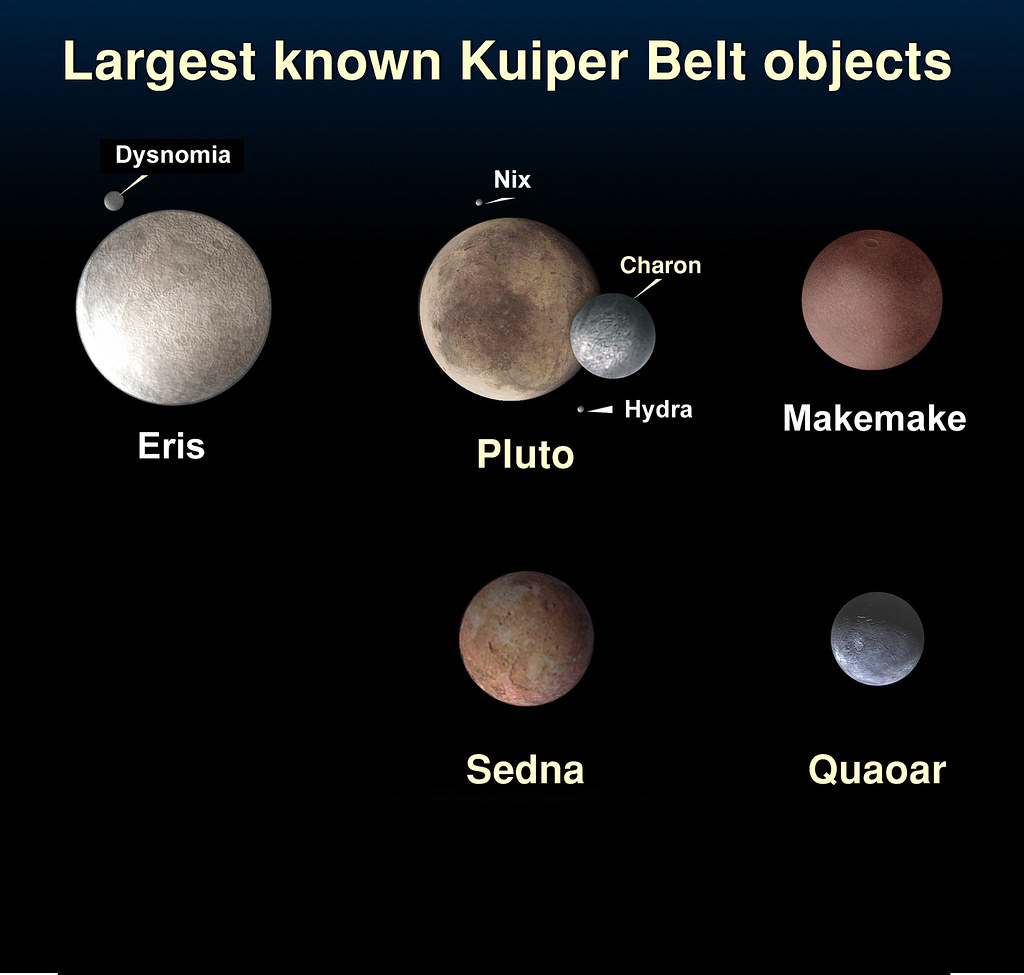
Artist’s conception of the largest known Kuiper Belt Objects and their moons.
Credit: A. Feild (Space Telescope Science Institute) edited by Alice
“Makemake is the creator of humanity and god of fertility in the mythology of the South Pacific island of Rapa Nui, known to most speakers of English as Easter Island” says Emily Lakdawalla. Oddly enough, in the interim between discovery and official naming, Mike Brown and his cohort have been calling this solar system object “Easterbunny.”
Want More?
Emily’s got a great article over at The Planetary Society
Mike Brown’s Commentary (He’s the one who named it)
Where’d I Get My Info?
 Retrograde Motion
Retrograde Motion
So. You’ve heard of retrograde motion, and you’ve seen it in a planetarium or a video, and heard from your favorite astrologer that it means that now is not the time to start a new relationship, especially since the Moon is in Venus’s house (huh?). But now you want to explain it scientifically to someone, and you’re kinda stumped as to how to begin. What is retrograde motion really? Something about planets going backwards? Remember this: Retrograde happens when an inner planet laps an outer planet.
Different Kinds of Retrograde:
Retrograde is a common word. “Retro” means “backwards,” and “gradus” means “step,” put together you get “going backwards.” Let me mention the three top kinds of retrograde in astronomy:
Retrograde Rotation: any planet that spins opposite from the other planets is said to have retrograde spin. Venus is one such planet. This is caused by the tidal lock between Venus, the Sun, and the Earth.
Retrograde Orbits: any planet or moon that orbits in the opposite direction from others is said to be in a retrograde orbit. This is uncommon among larger ojects: the largest retrograde moon Triton (around Neptune), which is one of the reasons that scientists think it is a captured moon.
Apparent Retrograde: when a planet appears to go backwards in the sky. This is the more complicated one, so now we’ll launch into more detail. Remember this: Retrograde happens when an inner planet laps an outer planet (because inner planets are moving faster than outer ones).
Apparent Retrograde Motion:
As you go through a day, the stars, the Moon, the Sun, and the planets all appear to rise in the East, and set in the West, because the Earth is spinning.
As you go through a month or a year, the Sun appears to move from WEST to EAST across the background stars. Go into a planetarium (or download Stellarium) and try it. This is normal. This is called prograde or direct motion. Now watch the planets, start with Saturn or Jupiter, they also mostly move from WEST to EAST across the background stars. This is both because the Earth is revolving around the Sun, and because the planets themselves are revolving around the Sun.
Now watch Mercury for about two months. Yikes! Did you see that? It just went backwards. (No? Then go download Stellarium like I told you, and look at it! Here’s a video if you’re lazy: Mars in Retrograde) It traveled from EAST to WEST across the background stars? This is because it’s on the inside of the solar racetrack, and it just passed us. We’re eating Mercury’s dust. Remember this: Retrograde happens when an inner planet laps an outer planet.
WHAT?
Okay, let’s add some pictures, some Java applets, and some videos.
First, go play with this: applet from UIUC You’ll need to have Java installed and functional, and to start it going click the middle blank button.
Now, I have a worksheet for you. Hah! Thought you’d never get homework from AstroInfo, didn’t you? Seriously folks, this will help you understand it if you don’t get it yet. And I’m not grading it.
Drawing Fun!
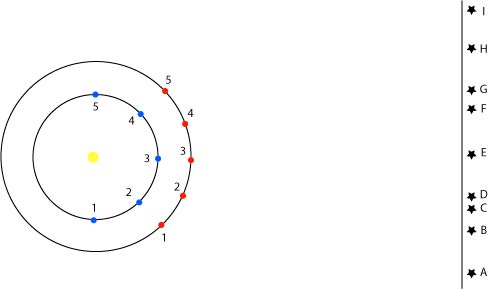
Earth and Mars from Above (NOT TO SCALE)
The inner (blue) dots are the Earth. The outer (red) dots are Mars. The lettered stars over on the right are background stars. As the Earth orbits the Sun, so does Mars. The numbers are to show time passing. When Earth is at position 1, Mars is at position 1. When Earth is at position 2, Mars is at position 2. Etc.
Draw a straight line connecting Earth 1 with Mars 1. Extend the line out to the background stars. These are the stars that Mars appears to be between, if you were looking up from Earth. If you look up from Earth at night, away from the Sun, you’ll see Mars, and some of the background stars.
Now do the same thing for Earth 2 and Mars 2. Do all 5 positions.
The Sky from Earth’s Point of View
If you were standing on Earth, looking up at those numbered stars, it would look something like this. Now draw in where Mars would be when Earth is at position 1 and Mars is at position 1. Repeat for positions 2-5. Be sure to number each Mars.
Connect the Mars dots from 1-5. You should get a loop. That’s Mars retrograding. Remember this: Retrograde happens when an inner planet laps an outer planet.
Here’s what I get:

Earth and Mars from Above

The Sky from Earth’s Point of View
Now go play with that Java applet again.
These drawings are not to scale, but they serve to get the point across. You’re welcome to try doing one for Mercury and Venus.
When you do, answer me this: which side of the Sun is Mercury on when it goes into retrograde? On the side closer to the Earth, or the side farther from the Earth?
Remember this: Retrograde happens when an inner planet laps an outer planet.
Want More?
Stellarium
YouTube Mars Retrograde Video
Retrograde applet.
Where’d I Get My Info?
The best dictionary ever, the Oxford English Dictionary. (if you have a library card with Seattle Public Libraries you get free access to their online dictionary).
 July-August Sky
July-August Sky
A guide for what’s coming up this month. I tried to include a fact and a lesser-known story for each object. I didn’t completely succeed. This guide is written to give hints to people who already know approximately what they’re looking at. For a good beginner’s guide to the sky, try StarDate, Sky and Telescope’s Stargazing Basics, or Sky and Telescope’s links to lots of beginning topics. (Or, if you know a better beginning stargazing site, put a link to it in a comment below!
New Constellations
ANDROMEDA – Princess Andromeda
Alpheratz is the star that connects Pegasus to Andromeda.
The Andromeda Galaxy is located in the constellation of Andromeda. It’s 2.2 million light years away, and the furthest thing you can see with your eyes. Period.
MYTH: Saudi Arabians called Andromeda “the sea lion”.
PEGASUS – The Winged Horse
Alpheratz is the star that connects Pegasus to Andromeda.
MYTH: The Greek Myth of Pegasus is long, complicated, and involves 6 constellations in the night sky. Queen Cassiopeia and King Cepheus weren’t all that great at being king and queen. Stuff happened, and they decided to sacrifice their daughter Andromeda to the sea monster Cetus. Perseus, returning from slaying Medusa, was riding on the back of Pegasus, who sprang from Medusa’s neck. Perseus killed Cetus, rescued Andromeda, and they lived happily ever after.
CEPHEUS – King Cepheus
Delta Cephei is a variable star, a whole type of variables are named after it.
Delta Cephei (Cepheid) variables are really useful stars. You can use them to judge distance, since the time between pulses is directly related to how bright the star actually is (the period-luminosity relationship).
MYTH: More of the Cassiopeia stuff.
PERSEUS – Perseus
The Perseid Meteor Shower (Perseids) will appear to radiate out of the constellation Perseus. This point is called the “radiant.”
MYTH: The Tale of the Hungry Skunk, A story about Auriga and Perseus: Salish tribe of the high plateau country of Washington, Oregon, and Idaho.
Once, when darkness was marching across the sky, the women of the sky country were preparing the evening meal. The men, who were sky fisherman, would be hungry when they returned and they were due home soon.
The women had built a large pit and placed some roots on hot rocks where the roots began to steam. A skunk smelled the cooking roots and followed the scent to see if it could get an easy meal.
It wasn’t long before the skunk found the village where the women were busy cooking and doing other evening chores. It walked toward the pit where the roots were steaming. A small child saw the skunk and asked his mother what that animal was. The mother screamed “Aieeee!”, grabbed her child, and ran away. Many of the other women soon did the same. But some of the women stayed behind to protect their hard work. They encircled the cooking pit and stared at the skunk. The skunk stopped and stood very still. It thought that if it stayed still long enough, perhaps the women would forget that it was there. The skunk is still in the sky, standing motionless, and the women are still standing around the pit, protecting their work.
(Sounds to me like Auriga is the circle of women, and Perseus is the skunk.)
SAGITTARIUS – The Centaur Archer
The center of our galaxy: if you see Sagittarius as a teapot, then the center of our galaxy, the Milky Way is right where the tea pouring out of the teapot would be.
MYTH: The Chinese see a dipper in Sagittarius. This dipper is part of the Black Tortoise. From: Chinese Constellations
CAPRICORNUS – The Sea Goat
This constellation is a decent-sized triangle. There aren’t really many interesting objects, and I can’t find any non-Greek myths. This is not my favorite constellation.
MYTH: Capricorn is a sea goat: half fish, half goat.
OPHIUCHUS – The Serpent Bearer
Ophiuchus is the 13th Zodiac constellation. It’s not part of the astrological zodiac, but it is along the ecliptic, and the sun spends a couple weeks passing through this constellation around November 30th through December 17th.
MYTH: Going for the gold? Find Serpens Caput (serpent’s head) and Serpens Cauda (serpent’s tail) beside either side of Ophiuchus to complete the story of the serpent bearer.
DELPHINUS – The Dolphin
In 1967 a nova went off in this constellation, and it could be seen with the naked eye. Now you need a telescope.
MYTH: The Chinese see this constellation as a gourd.
JUPITER
Don’t miss Jupiter in tonight’s sky!
“Tiny” Guys
Going for the Gold? Here’s this month’s itty-bittys.
SCUTUM – The Shield
CAMELOPARDALIS– The Giraffe
LACERTA – The Lizard
SERPENS CAPUT – Serpent Head
SERPENS CAUDA – Serpent Tail
EQUULEUS – The Little Horse
SAGITTA – The Arrow
VULPECA – The Fox
CANES VENATICI– The Hunting Dogs
Returning Constellations
I tried to include new stuff about most of these.
AQUILA – The Eagle
MYTH: The Japanese see Altair as a Cowboy and Vega as a Weaver girl. They are very much in love, but due to circumstances are separated – except for one day a year (the 7th day of the 7th month of the lunar calendar) the lovers get to be together, but only if it’s clear.
CYGNUS – The Swan or the Northern Cross
Albireo (the head star) is a beautiful double star
MYTH: To the Saudi Arabians, Cygnus was alternatively a hen or a swan. To the Chinese, the creature was a magpie.
LYRA – The Harp
Vega will be our North Star in about 14,000 years.
MYTH: to the natives of Bohemia, Lyra is “the fiddle in the sky”
SCORPIUS – The Scorpion
BOOTES – The Farmer
MYTH (From Zeta): This constellation is often seen as a grapevine (think “cluster of hanging grapes”).
CORONA BOREALIS – The Northern Crown
MYTH: The Housatonic Native Americans believed Corona was the cave home of Ursa Major.
HERCULES – Hercules
M13 Hercules Globular Cluster
Globular Clusters are gravitationally-bound groups of 1000s to 10s of 1000s of stars. They tend to be outside of the galactic plane, and are the oldest stars in a given galaxy.
URSA MAJOR – The Great Bear
URSA MINOR – The Little Bear
CASSIOPEIA – The Queen
MYTH: The Arabs also saw hand imagery in the constellation, referring to it as “the large hand stained with henna”. In viewing this constellation as a hand, each of the five prominent stars in it would represent a fingertip.
Happy Sky Viewing!
 Stargazing Opportunities
Stargazing Opportunities
Podcast for Summer Stargazing in Seattle
Summer Stargazing in Seattle
Looking for stars in Seattle? The further you can get from streetlights, the better. Darkness is what you need for the best stargazing.* If you’d like to join other astronomy enthusiasts, try one of these local events!
Star Parties:
The Seattle Astronomical Society hosts stargazing parties in two locations in Seattle. http://www.seattleastro.org
Green Lake Star Party: Green Lake star parties are on the north shore at a grassy area west of the Bathhouse Theater, near the fishing piers on the lake.
July 12th and August 9th at 7pm
Paramount Park Star Party: The park address is NE 155th and 8th NE in Shoreline.
July 12th and August 9th at 7pm
UW Observatory Open House:
Look through the UW’s 110-year-old refracting telescope, and listen to a short talk. The observatory is located in the northwest corner of the campus. http://www.astro.washington.edu/observatory/
July 2nd and 16th at 9pm
August 6th and 20th at 9pm
*Please use caution walking in the city in the dark. Also, be aware that many of Seattle’s Parks close at sunset.
Further Afield
Getting out of the city makes for even better views of the sky. Here are some of my favorite stargazing locations within a few hours of Seattle. Most of these are fee-based public areas.
Campground on Lake Kachess
In the Cascades just off I-90. The boat ramp has a good view towards the Northeast (perfect for Perseid viewing). Be sure to talk to the ranger beforehand though, the boat ramp is in the “Day Use Only” section of the park. Info: www.reserveamerica.com
Lake Ozette in Olympic National Park
Near the tip of the Olympic Peninsula, has a good reputation. Stay near the water (out of the trees) for the best sights. Info: www.nps.gov , Brochure
Bowman Bay Campground
The Boeing Employee’s Astronomical Society recommends Bowman Bay Campground in Deception Pass State Park on Whidbey Island. Info: www.parks.wa.gov
Staircase Campground
My favorite stargazing location, Staircase Campground in Olympic National Park, is closed due to road-washout and should reopen sometime this summer. If you get there, sit on the bridge for the best views. Info: www.nps.gov , Brochure
The Perseid Meteor Shower
If you spend any time stargazing this summer, be sure not to miss the Perseid meteor shower.
Dates: July 17-August 24th
Time: After midnight
Best Viewing: August 12 12am-3am
To see the Perseids, turn to face the constellation Perseus, which will be rising in the Northeast a bit before midnight.
Pacific Science Center’s Starmap for July and August
Where’d I Get My Info?
UW Observatory:
http://www.astro.washington.edu/observatory/
Seattle-Area Astronomy Events:
http://www.seattleastro.org

